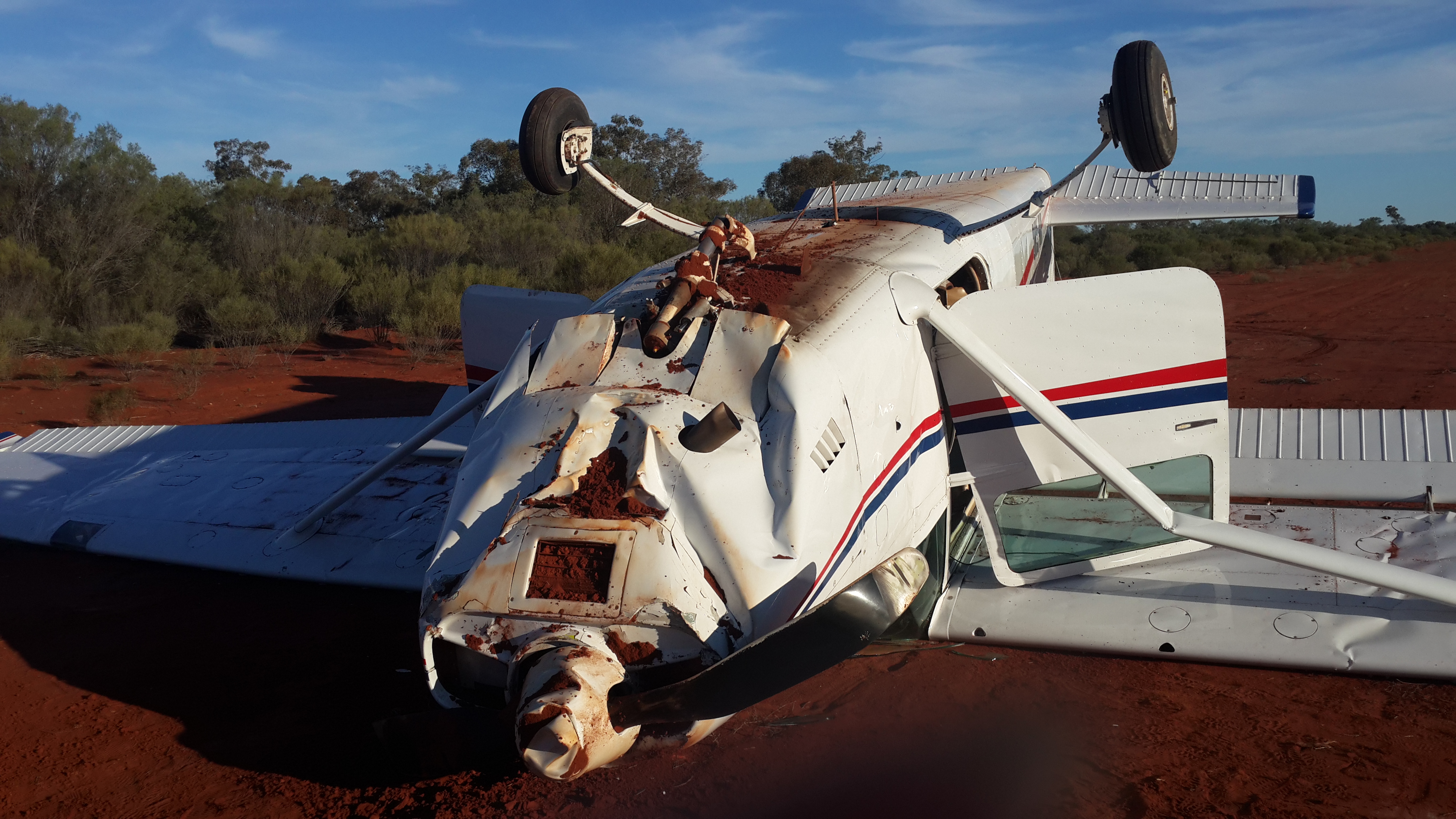What happened
On 5 July 2015, the pilot of a Cessna 182 aircraft, registered VH-AHC, conducted a local flight from a private airstrip about 100 km south-west of Bourke, New South Wales. The aircraft took off towards the west. After a flight of about 15 to 20 minutes, the aircraft returned overhead the airstrip. Based on the indicated wind, the pilot elected to conduct an approach to land towards the south.
When on final approach to land, at about 5 ft above ground level, the aircraft sank rapidly. The aircraft landed heavily and the nose wheel detached from the aircraft. The aircraft then bounced into the air, touched down for a second time, and dug into soft ground. The aircraft flipped over and came to rest inverted, resulting in substantial damage (Figure 1). The pilot and two passengers sustained minor injuries.
Pilot comments
The pilot reported that the property had received about 100 mm of rain over a period of 2 weeks, which had stopped about 7 days prior to the incident. Cold weather in the intervening period had prevented the soil from drying. Prior to taking off, the pilot had driven over the runway surface and assessed the surface to be suitable for landing. However, below the runway surface, there was a soft layer of earth. This layer extended about 500 mm down and was not evident during the runway inspection.
The pilot was unsure what caused the aircraft to sink faster than usual. The wind was light and variable. The additional sink and high rate of descent combined with the soft surface led to the aircraft landing gear digging in and flipping the aircraft over.
Figure 1: Accident site of Cessna 182, VH-AHC

Source: Aircraft owner
Safety message
This incident highlights the importance of the identification and management of risks associated with unsealed airfields. Potential hazards such as changes in the runway surface following rain can be hard to detect. Changes in the runway surface can adversely affect the outcome of a hard landing.
The ATSB report regarding a similar incident is available on the ATSB website at AO-2015-038.
Aviation Short Investigations Bulletin - Issue 42
Purpose of safety investigationsThe objective of a safety investigation is to enhance transport safety. This is done through:
It is not a function of the ATSB to apportion blame or provide a means for determining liability. At the same time, an investigation report must include factual material of sufficient weight to support the analysis and findings. At all times the ATSB endeavours to balance the use of material that could imply adverse comment with the need to properly explain what happened, and why, in a fair and unbiased manner. The ATSB does not investigate for the purpose of taking administrative, regulatory or criminal action. TerminologyAn explanation of terminology used in ATSB investigation reports is available here. This includes terms such as occurrence, contributing factor, other factor that increased risk, and safety issue. Publishing informationReleased in accordance with section 25 of the Transport Safety Investigation Act 2003 Published by: Australian Transport Safety Bureau © Commonwealth of Australia 2015
Ownership of intellectual property rights in this publication Unless otherwise noted, copyright (and any other intellectual property rights, if any) in this report publication is owned by the Commonwealth of Australia. Creative Commons licence With the exception of the Coat of Arms, ATSB logo, and photos and graphics in which a third party holds copyright, this publication is licensed under a Creative Commons Attribution 3.0 Australia licence. Creative Commons Attribution 3.0 Australia Licence is a standard form licence agreement that allows you to copy, distribute, transmit and adapt this publication provided that you attribute the work. The ATSB’s preference is that you attribute this publication (and any material sourced from it) using the following wording: Source: Australian Transport Safety Bureau Copyright in material obtained from other agencies, private individuals or organisations, belongs to those agencies, individuals or organisations. Where you wish to use their material, you will need to contact them directly. |


